Last Updated on April 27, 2023
A wonderfully intuitive dog that has been used for herding. These medium-sized dogs were mixed with both the Collie and the Border Collie to create the ultimate shepherd.
While Aussies originally started in Europe and were further refined in Australia and later, America, Californians mistook them for Australian, and thus the name Australian Shepherd was born.

The American Kennel Club accepted them by 1993.
Quick Navigation
- 1 History of Australian Shepherd Colors
- 2 How Do Australian Shepherd Color Genetics Work?
- 3 What are the Breed-approved Australian Shepherd Coat Colors?
- 4 What is the Rarest Australian Shepherd Color?
- 5 Do Australian Shepherds Change Color as They Age?
- 6 Do Australian Shepherd Colors Affect Behavior?
- 7 Do Australian Shepherd Colors Affect Health?
- 8 How About Australian Shepherd Eye Color?
- 9 Taking Care of Your Australian Shepherd’s Coat
- 10 Which Australian Shepherd Color Will You Choose?
- 11 Further reading: Australian Shepherd mixes
- 12 Reference
History of Australian Shepherd Colors
Often called the Basques’ little blue dog, the Australian Shepherd is a mix and match of many different dog breeds.
Bred solely to be herding dogs, farmers would put two efficient dogs together to create an even better pup, with no regard to color. Perhaps this is why Australian Shepherds come in so many color varieties.
As any breeder might tell you, watching a litter of Aussies being whelped is a surprise from start to end. The most popular in the United States is the blue merle coat, and it’s easy to see why.
The merle pattern is a special curiosity, giving dogs a splattered coat.
How Do Australian Shepherd Color Genetics Work?
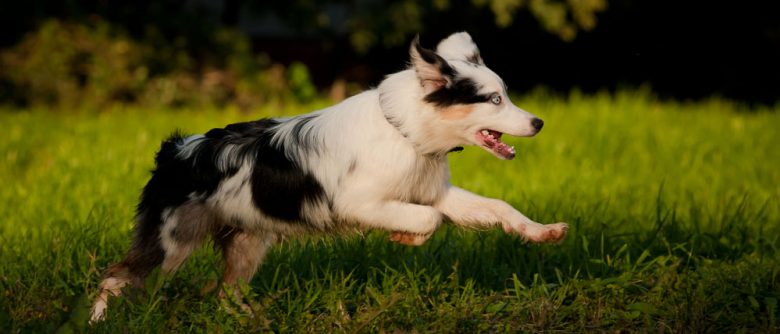
Merle is a dominant gene, and it can affect both red and black dogs. Black dogs with the merle pattern are called blue merle instead of black merle because they look blue from afar.
Most of the colors discouraged from both the AKC and the Australian Shepherd Club of America come from recessive genes.
Some fans of the breed insist that dogs that don’t fit the breed standard aren’t even purebred. However, that’s not how genetics work.
Certain genes are suppressed by other genes and will only appear in puppies if the other parent dog has the same gene.
While you can get merles by breeding one with any solid-colored dog, you will need to breed two dogs with the dilute gene to get a blue or liver puppy. That’s what recessive genes mean. They need two to tango.
Now, ranchers and breeders have long since discovered that merles should not be bred together.
In any breed, homozygous merle pairings increase the risks of producing defective pups with health problems and deafness.
Red is a funny recessive gene because when you breed red to a black red-factored dog (one that carries the gene and doesn’t express it), you’ll most likely end up with more red dogs instead of black.
However, if you don’t breed them to a dog that carries the red gene, you will never get a red pup.
What are the Breed-approved Australian Shepherd Coat Colors?
The American Kennel Club writes that Aussies can only be “blue merle, black, red merle, red-all with or without white markings or tan (copper) points.”
In layman’s terms, it means that their base color can be blue, black, or red, and specific white and tan markings are acceptable.
Black Australian Shepherd
The black tri shepherd looks very much like a Bernese Mountain Dog. They have a white undercarriage, a black body, and tan markings around the lower legs and above the eyes.
They very often have a white blaze on their heads, which connects to a white muzzle.
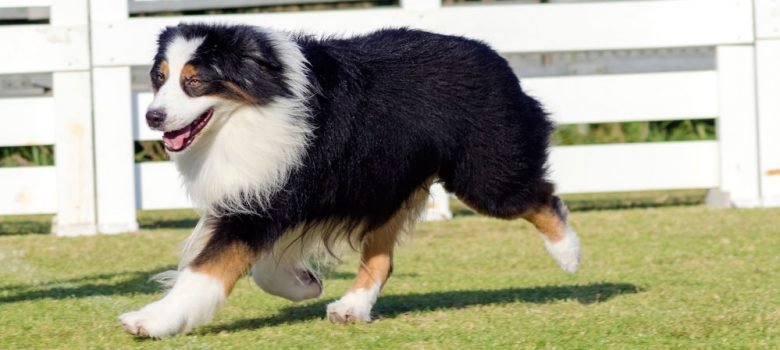
While the most common black shepherd is tri-colored, they can also be solid black or have either white or tan markings.
One of the rarest Australian Shepherd colors is Black and Tan. As you can imagine, they look a lot like sleek and fluffy Rottweilers.

A black and white Australian Shepherd is called a Black Bi Aussie. As you can see below, they don’t have any tan markings. The white is generally confined to the muzzle, chest, and undercarriage.
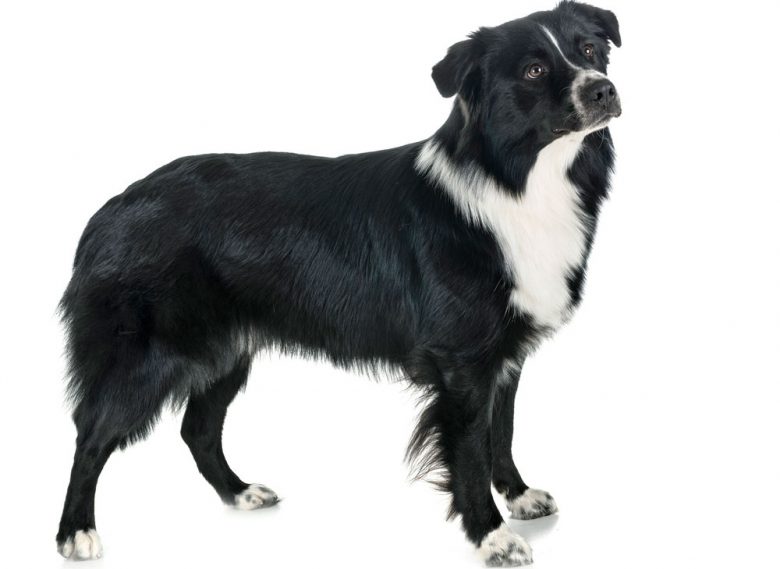
Solid black Aussies are the least popular choice and therefore are also an uncommon sight. They might sometimes have a splash of white on their chests but will not sport any other markings anywhere else on their body.
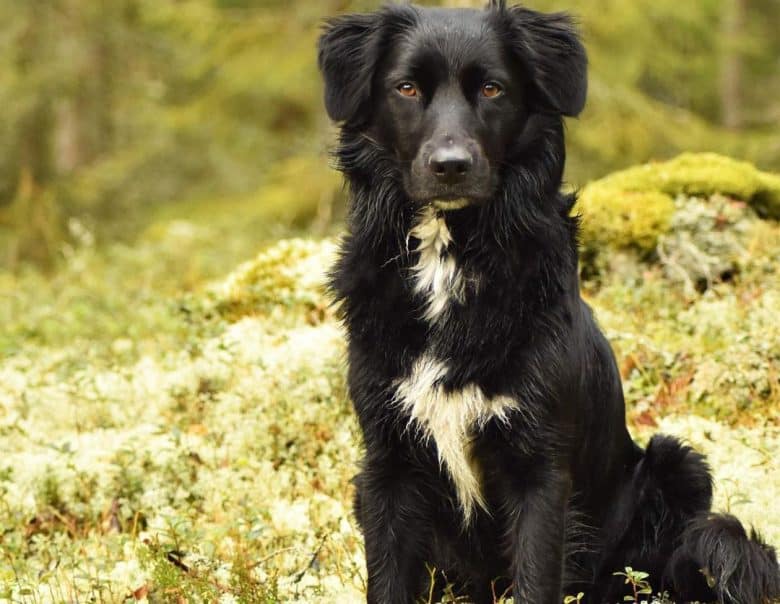
Red Australian Shepherd
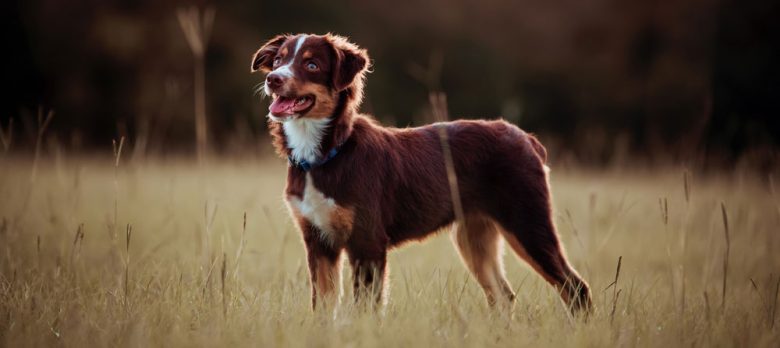
Red Australian Shepherds can also be bi-colored or tri-colored. The red tricolor will be a mixture of red, with tan markings and a predominantly white chest.
The red tri can also have white faces and legs. However, the red and white can sometimes have very minimal white.

Solid red Australian Shepherds aren’t terribly popular, which is probably why they are the rarest color.

These dogs will have liver-colored noses, eye rims, and paw pads. This is because the gene that makes red suppresses the black pigment, so none should come through.
Red dogs with black pigment aren’t true reds. Aside from that, their red ranges from light orange to a deep russet color, making this variation the most colorful one of all.
Red Merle Australian Shepherd
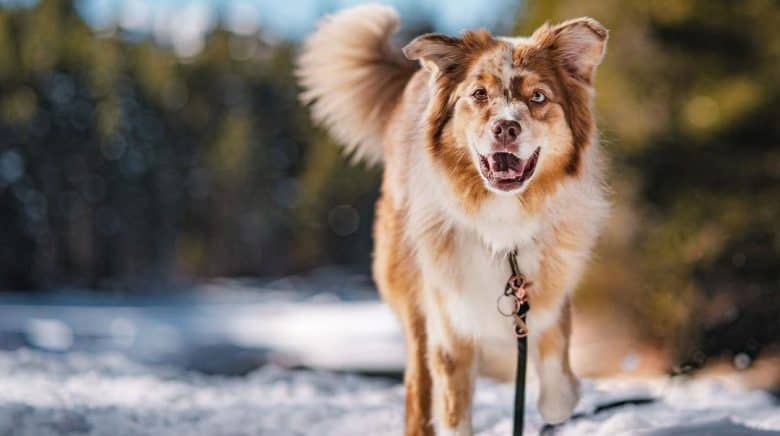
Red Merle Australian Shepherds also come in three variations. You can get a solid red, a tri-colored merle red, or a bi-colored merle red, although it’s a bit harder to tell them apart.
These dogs are quite a sight to behold, with their silvery coats spotted in red. The copper highlights on the tri-colored merle are usually confined to the face and legs.
Solid Red Merles and Bi-Red Merle Aussies are almost impossible to differentiate as they have lots of white.
However, it’s arguable that the solid red merles have a more uniform look than the sporadic spotting on bi-red merles.
It’s extremely rare to see a Red Merle Aussie with tan markings alone. Most of the time, it’s so minimal that it doesn’t even count as its color.
Take a look at Ginger, the gorgeous Red Merle Aussie:
Blue Merle Australian Shepherd
The Blue Merle Aussie with its blue eyes is a dazzling dog indeed. This is especially true for solid blue merle Australian Shepherds.
Their coats of grey can range from silver to slate grey, spotted in black. There will be no white markings anywhere except possibly the chest.

There is more white in tri-colored dogs, and they have tan markings around the legs, face, and chest. In bi-colored shepherds, there’s a distinct lack of any tan shades in their coats.
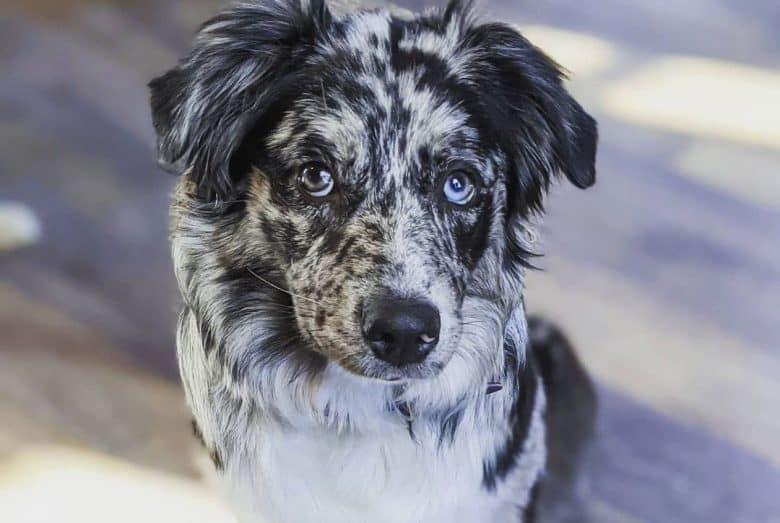
Unlike the other color variations, Blue Merle Australian Shepherds come in one additional color: the blue merle and tan coloration.
Imagine a solid blue merle Aussie with tan points. They aren’t quite common, but they do crop up every once in a while.
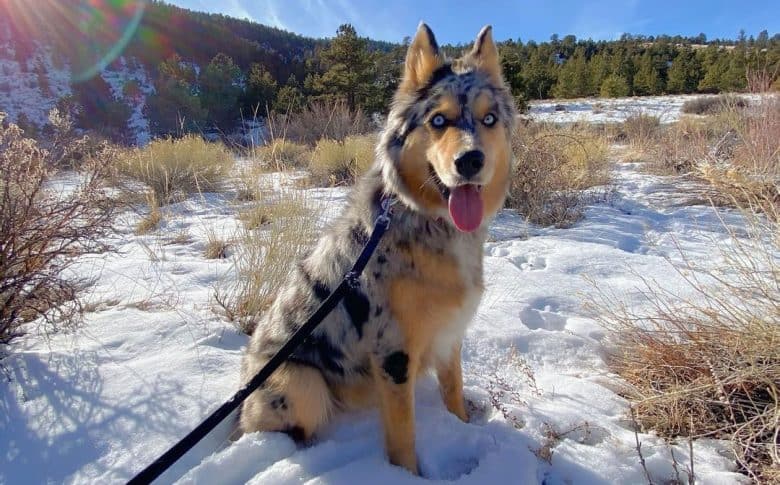
What is the Rarest Australian Shepherd Color?
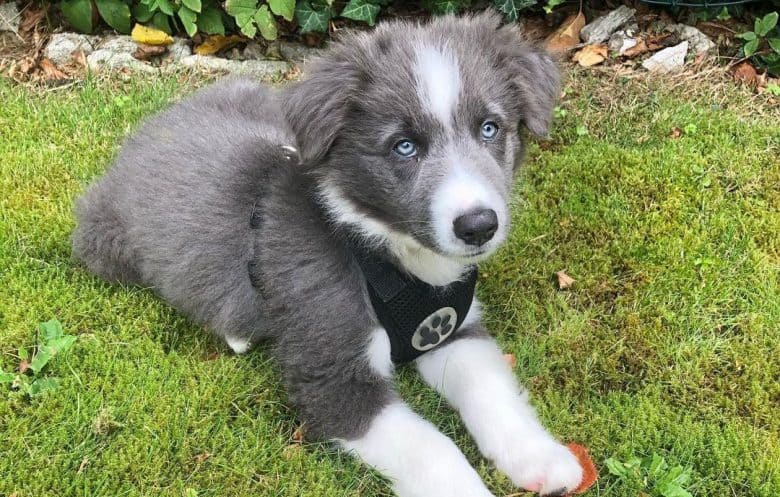
The most common disqualifying color is dilute. Australian Shepherd dogs with the dilute gene will have their red or black pigments watered down, creating liver or blue.
It takes two parents with the recessive gene to produce puppies with this faded coloring, so it’s easy to prevent this undesirable coloring with genetic testing.
Similarly, the Yellow Australian Shepherd also inherits this gene from both parents. They are red or yellow dogs with black noses. This is seen as a fault by the AKC as red dogs should only have liver pigmented noses.

Funnily enough, the dilute gene doesn’t affect the tan coloration, but the yellow gene does.
You can expect to see anything from a light Labrador yellow to a deep russet yellow, which can be easily confused with red merle dogs. Some might even mistake them for sable dogs.
The key difference is that in sable dogs, the individual hairs are tipped with black.
Certain colors are undesirable because some of them are linked to health problems. Many dog breeds with the dilute gene might inherit the color dilution alopecia, but this doesn’t seem to happen with the Aussie.
Dilute can be rather striking, especially when paired with the merle coat. It only happens with Australian Shepherd dogs because their dilute coat tends to darken with age until they no longer look mismarked.
According to the AKC, another instance of a mismarked dog is a dog with white markings on the body. Aussies shouldn’t have white past their withers or on their lower backs or hindlegs.
An excessively white dog or one with extensive white trim is often a double merle. But, it’s dogs with white around their ears that have the higher potential of being deaf.
Is it okay to get a rare-colored Australian Shepherd?
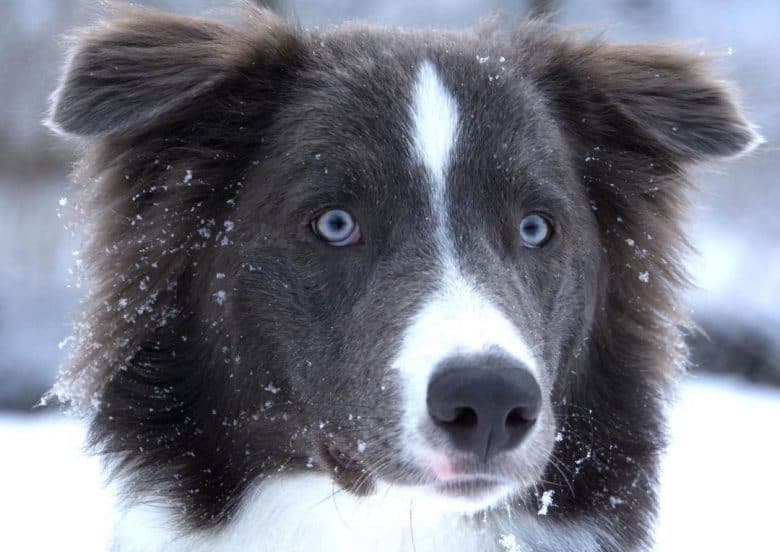
The breeding community often ostracizes breeders that breed specifically for color because dogs should be bred for conformity and temperament instead of aesthetics.
However, the truth is that certain colors are more desirable, and it shouldn’t be a problem selecting the color of your choice, as long as you acquire your puppy through ethical means.
You can either adopt from a shelter or spend time looking for a breeder dedicated to improving the breed. A responsible breeder doesn’t just care for their dogs, but they should care about the breed as a whole.
Australian Shepherd Markings
As you can see from the color categorization above, some distinct markings are unique to the Aussie breed.
Merle is a spotting pattern. The dog’s coat can be exclusively merle, or it can be confined to certain areas. Tan points are tan spots above the eyebrow, tan markings around the face, and leg zone.
White markings should be around the face, neck, chest, and undercarriage only.
Australian Shepherd Markings (Unrecognized)
Despite having so many different colors, a few go unrecognized in the Australian Shepherd breed.

Sable is common across dog breeds but most often associated with working types, although toy breeds such as Pugs and Chihuahuas can also be sable.
This coloration must have come from the Aussie’s Collie ancestor as they were the only breed carrying this gene to be bred with the Australian Shepherd.
The gene is found in the agouti or wild-type genome, and there are three known variants of Sable Australian Shepherds.
The most dominant is the wolf sable, in which no tan or cream will be present in their grey and silver coats. One type causes a tan trim, which is absent in another.
Since sable is a pattern, it can be exhibited alongside the merle gene. This causes the dog to look rather muddy and unattractive, which is why merle and sables tend to be bred separately.
Saddle Pattern is an iconic German Shepherd marking, but it can also appear in the Australian Shepherd. It’s relatively uncommon as it doesn’t happen naturally in a pairing of two standard-color Aussies.
At least one parent must be a carrier of sable, yellow, or have the saddle pattern.
The pattern manifests as a black blanket over the dog’s back. There can be many color combinations with this pattern, from pale cream to a rich copper red that colors the rest of the dog.
They can even have white markings or tan points.
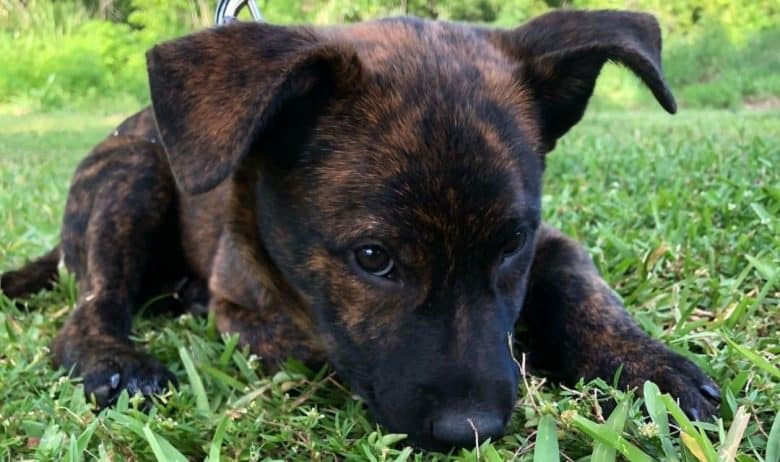
Brindle is easy to distinguish on short-coated breeds such as the Frenchie or Greyhounds, but it’s less obvious on long-coated dogs like the Australian. Brindle dogs have striped coats.
Do Australian Shepherds Change Color as They Age?
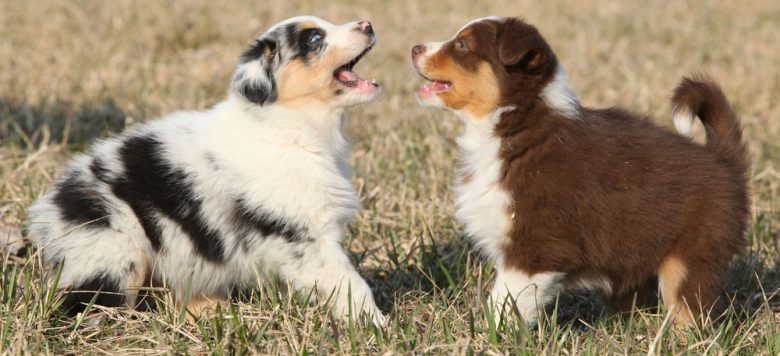
The dog’s coat can change slightly as the dog ages. In some breeds such as the Pomeranian, dogs are expected to look entirely different as adults.
The Aussie working dogs, on the other hand, have a predisposition to become lighter with age. Blue merle puppies often start quite dark, lightening into a soft grey.
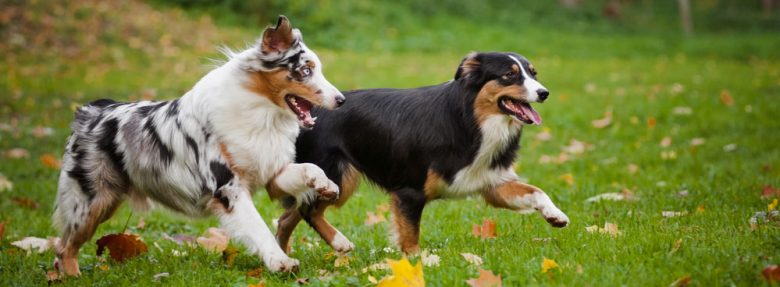
Dogs that have a white blaze on their heads can sometimes lose them. This has also been noted in Collies.
Why do Australian Shepherds lose their color?
It is all due to age. Dogs can either darken or lighten with age. Aussies that spend loads of time in the sun are also prone to losing their pigment.
Much like humans getting a sunburn, sun exposure can cause pigment damage. However, this is only temporary, and your dog should regain its vibrancy when they molt their coat.
Do Australian Shepherd Colors Affect Behavior?

Color should never affect temperament. If it does, it just means that the breeder is neither responsible nor considerate.
These dogs should be calm and courteous with proper socialization. Well known for their high energy and trainability, you can expect to play flyball or frisbee with them for hours on end.
While you need to take them out every day, you should be wary of how long you exercise, especially if your dog is still young. Find out why below.
Do Australian Shepherd Colors Affect Health?
Aussies can be prone to hip dysplasia, which affects many medium-to-large breed dogs, regardless of color. The disease affects their joints, and it’s something to consider when deciding on diet and exercise.
Puppies shouldn’t be overexerted, and adults shouldn’t be overfed.
Getting your Aussie from a reputable breeder is the only factor in determining how healthy your fido will be. Bad breeding practices exacerbate many health concerns. Remember what we said about double merles?
How About Australian Shepherd Eye Color?
Perhaps one of the most interesting features of the Aussie is their eyes. Much like Huskies, they can have different colored eyes. Their coat color does play a small part in what color eyes they may have.
For instance, a Black Aussie, regardless of markings, will often have brown eyes.
Red Aussies often have amber or blue eyes, although it’s possible to find one with both. Red Merles, on the other hand, usually have blue or bi-colored eyes.
Blue Merles very often have blue eyes or blue highlights in their brown eyes and vice versa. You can also find them with two different colored eyes, although marbled blue eyes are most common in this color.
Taking Care of Your Australian Shepherd’s Coat
The Australian Shepherd has a double coat to protect him from the elements. It would be best if you never shave his coat unless recommended by a vet.
These are working dogs, and they shouldn’t be too high maintenance. This means you don’t need to groom them on a daily basis. If you did, they wouldn’t be very effective on the field.
It would help if you combed his coat at least once a week to dislodge any burs and tangles. It can also keep your doggie’s fur soft and shiny.
When they blow out their undercoat, you will want to up that frequency to give him a daily brush.
Which Australian Shepherd Color Will You Choose?

Known for their intelligence and often used as search-and-rescue dogs and seeing-eye dogs, Aussies are simply one of a kind.
You have to admit that Australian Shepherds of all colors are simply endearing. These sweet and affectionate dogs have the energy to match.
I won’t deny that the bicolor eyes of merle dogs are enticing, but these sheepherders are more than their looks.
Further reading: Australian Shepherd mixes
Not sure if the Australian Shepherd is for you? Or maybe you’re interested in reading all there is to know about them!
Well, there are a few Australian Shepherd crossbreeds that have been taking off in recent years. Here are a couple of them!
Reference
- https://images.akc.org/pdf/breeds/standards/AustralianShepherd.pdf
- http://www.ashgi.org/home-page/genetics-info/coat-color/color-clashes
- http://color.ashgi.org/color/Color_changing_Aussies.html
Cess is the Head of Content Writing at K9 Web and a passionate dog care expert with over 5 years of experience in the Pet Industry. With a background in animal science, dog training, and behavior consulting, her hands-on experience and extensive knowledge make her a trusted source for dog owners.
When not writing or leading the K9 Web content team, Cess can be found volunteering at local shelters and participating in dog-related events.
